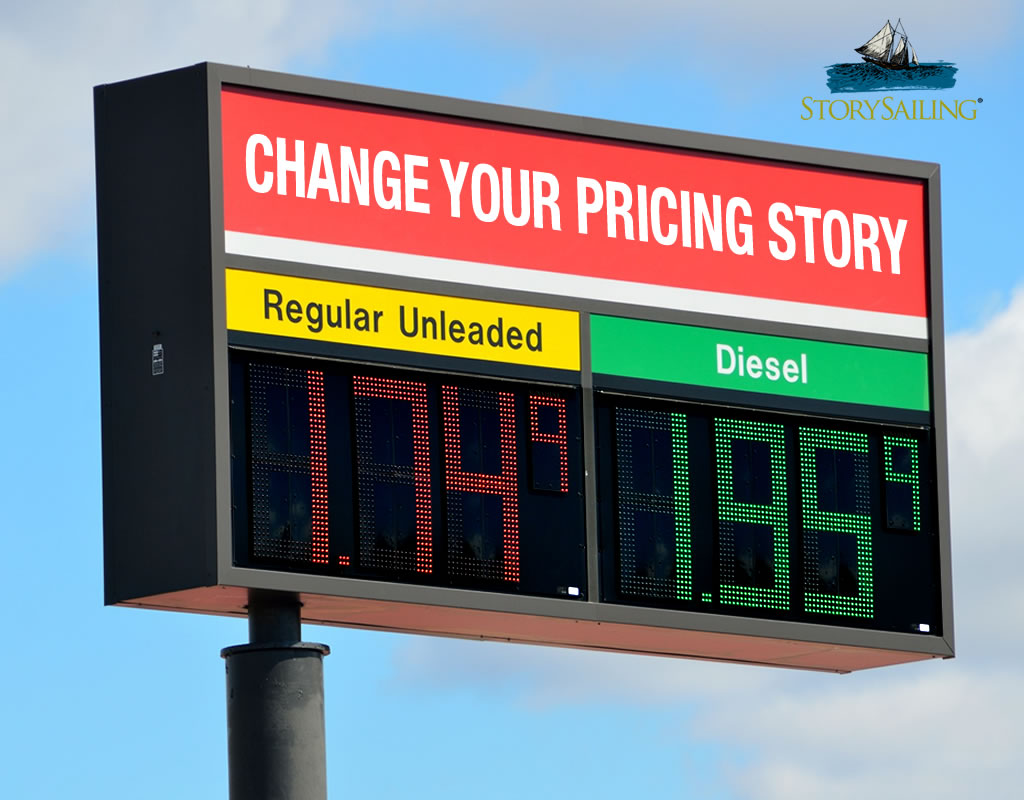Change Your Pricing Story

Should you charge $20 for your new book or $19.97? Will dropping your price by three cents help you sell more books? What about smart consumers who are educated about sales and marketing? Will they think you’re being manipulative? And do you really want to carry a roll of pennies around to make change with?
The price of almost every product or program we see is rounded down to an odd number. Sellers are willing to sacrifice a tiny slice off the top to entice you to click the BUY button.
And what about those oddball fuel prices? Back in the 1930s, gas was priced at under ten cents per gallon. A one-cent tax added to a gallon of gas would have meant a markup of over 10%. Gas station owners softened the psychological blow by reducing the price by 1/10th of a cent and then adding the penny, and that absurd pricing practice continues to this day.
Probably, you’ve seen “offer stacking” in professional development programs that looks like this:

It’s assumed that customers will conclude that the odd prices are based on calculated value factors while charging $2000 for the program would be considered arbitrary. Of course, it’s the prices of the components of the program as well as the “savings” that are arbitrary. People fall for this kind of malarky every day … but if you’ve taken a business class, read a business book, or had any kind of sales training, you’re probably thinking, I already know this.
You’ve already been told about studies that prove that an item priced at $19.99 will sell more units than one priced at $20. And WalMart would price that same item at $19.88 to take advantage of this natural bias and imply that their price offers an even bigger discount. But the conclusions of studies on consumers’ responses to pricing vary widely.
Could this pricing strategy backfire?
“Odd-even” pricing has become so commonplace that we hardly notice it any more—even in those ridiculous fraction-of-a-penny prices at the gas station.
And that’s the problem. Sales used to be a numbers game. If you broadcast a television advertisement on Thursday night at 7:00pm when millions of Americans had gathered in front of their television sets, some of them would remember your brand and buy Tylenol instead of Bayer when they got to the market.
If you offer retail products direct to consumers, psychological manipulation strategies that rely on odd-even pricing may continue to serve you well. But today, sales—especially in the professional space—is a connection game more than it is a numbers game. When the prospect you connect with can tell instantly that your pricing has a hook buried in the bait—that you’re attempting to soften the sticker shock with a cheap trick—will they be less inclined to do business with you?
Unless you offer a product that came out of a factory, your pricing is probably based on what competitors charge, your willingness or reluctance to do the work, market conditions, the urgency of your client’s needs, the size of their wallet, and attempts to manipulate perceived value (which is another psychological selling strategy).
And those who charge by the hour eventually run into trouble when they acquire the skill to perform at twice the speed of their competitors.
Which brings us to a fundamental principle of sales:
Sales is the art of changing the conversation from price to value.
Discussions of price are a race to the bottom; someone will always offer to do the work cheaper than you. But if you offer value in excess of your fee, price becomes irrelevant. A speaker who charges $30,000 for a keynote speech about employee retention knows that it costs $15,000 to on-board a new tech industry employee. If their talk helps leaders keep teams at the table, the lines on the price/value graph cross quickly.
But what would an event organizer think if that speaker charged $29,999.97 for that same program?
It’s every bit as absurd as splitting pennies on gas prices. The conversation shifts back from value to price!
![]()
Probably, most people won’t notice or care if you shave three pennies off your price—or even hacksaw off a tenth of that last penny—but if you’re angling for sophisticated fish, you could be selling your first impression for a few cents.
How do you react when you encounter odd-even pricing strategies? Do you notice them? Do you trust them? Leave your comments in the chat.



I qualify for Medicare. We are allotted $50 per quarter for over the counter medicines. The program is managed by Walmart. In the past the prices ended anywhere between .00 and .99. This year I noticed that every price in the catalog ended in .99. That means they are making an extra few cents or almost another dollar on each purchase—above their mark-up. Since they sell things like toothpaste, it is possible to order ten or more items for your quarterly $50—which means Walmart is pocketing an additional 20% or so from every senior citizen’s Medicare benefit. I complained. The pricing made me distrust the vendor. The January catalog was back to the usual pricing.